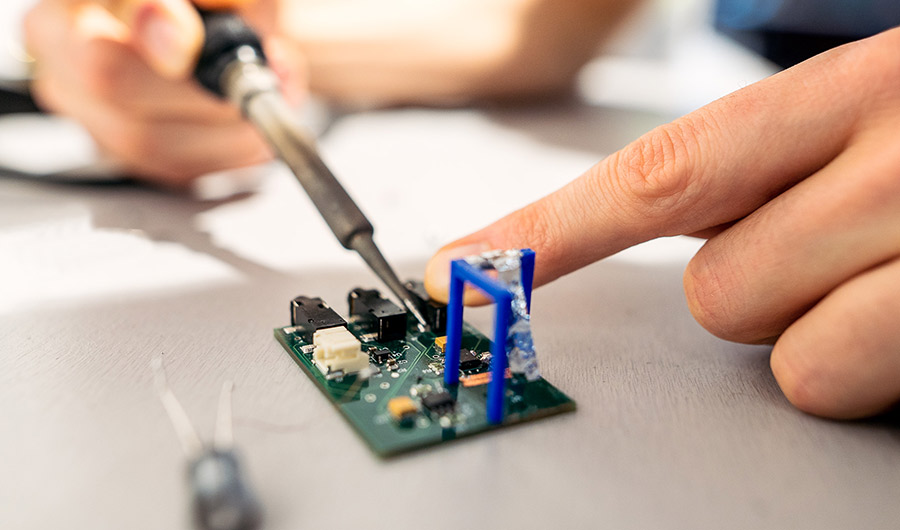Researchers Mimic Biology to Make a Better, 'Buggy' Microphone

The protoype of Soundskrit's acoustic flow microphone mimics the way that insects hear.
Image credits: Daren Zomerman
(Inside Science) -- Secret agents who snoop around and hide bugs that listen to the conversations of others are a staple of spy and suspense movies. Inspired by the hearing of actual insects, researchers may be able to design new kinds of bugs and other microphones.
Insects and other animals often hear by sensing the flow of air over hairs or antennae instead of detecting pressure -- in the form of sound waves -- the way human ears and most modern microphones do. Now, in an example of what is called biomimetics, researchers have been inspired to design new microphones based on the way many insects and other animals detect sound.
At a meeting of the Acoustical Society of America in Louisville on May 14, two presentations discussed the potential of using the insect-inspired technique of using the flow of air to detect sound. They argued that this approach may allow the development of smaller microphones that can detect the direction a sound is coming from.
“These animals, they have been around for a long time, and then they had a chance, in the course of evolution, to test a lot of things and come up with really good solutions,” said Rolf Müller, a mechanical engineer who studies the bioacoustics of bats, in an interview. “They have evolved to really make the best use out of the physical acoustical phenomena.”
Ronald Miles, a mechanical engineer at Binghamton University in New York, presented his research on making such microphones using thin fibers. He has shown that a spider silk fiber can be used to make a microphone that doesn’t distort the sound for the range of frequencies that humans can hear, in a 2017 article in the journal Proceedings of the National Academy of Sciences. At the meeting he discussed new work that shows that a small thin beam can also be made to move with the air in the same useful way a fiber or hair can.
Miles told Inside Science that when things get very small, the way air moves them changes.
“The smaller they are, the more important viscous forces are,” said Miles. “So, air kind of acts like a syrup when you have very, very tiny size scales.”
Miles advises a startup called Soundskrit that was inspired by his work. At the same meeting, the company discussed their work to implement Miles’ principles as a commercially manufacturable product.
“We have bigger prototypes that were made in a lab,” said Stephane Leahy, one of Soundskrit’s co-founders, also in an interview. “We're trying to make something that's a quarter the size of your fingernail.”
According to Miles, they think that a porous film may be easier to mass-produce with current manufacturing techniques than thin fibers.
When detecting airflow, the thread or beam is sensitive to the direction the air is moving but with a pressure wave the whole membrane moves and is not very sensitive to the direction. This makes airflow-based sensors more convenient for determining the source of a sound. That approach could help devices such as smart speakers focus on commands. With traditional microphones you need multiple microphones that are separated from each other so you can detect differences based on the location of each microphone. But with microphones detecting flow, multiple sensors can be located closely together and still indicate the direction a noise originates from.
“It's very important for the smart speaker to focus its attention on you and avoid the sounds coming from all over the room,” said Miles. “And so, there's a lot of technology in these things to create a directional sound sensing system. If the microphone itself could be made directional, then it makes that whole process a great deal easier. And you could get by with fewer microphones and make it cheaper.”
“I think it's really beautiful work,” said Müller. He said that people have struggled to solve the problem of detecting the direction of sound with something tiny.
This technology may seem like it should be rendered useless by a light breeze, but the researchers found the solution by looking at insects. Miles notes that mosquitoes are able to use a similar technique to hear even while flying. The fibers or films can be designed like the insects’ hairs so that they have resonance modes where they react strongly to the certain frequencies of motion -- similar to how guitar strings resonate at different frequencies.
“It's a little complicated in this case, but you know, everything has a lowest resonant mode,” said Miles. “And what we want to do is make sure that the lowest frequency mode of the structure is not ridiculously low.”
While this technology is not yet on shelves, Leahy estimates that Soundskrit needs about a year-and-a-half to two years to get the technology to a salable product.

